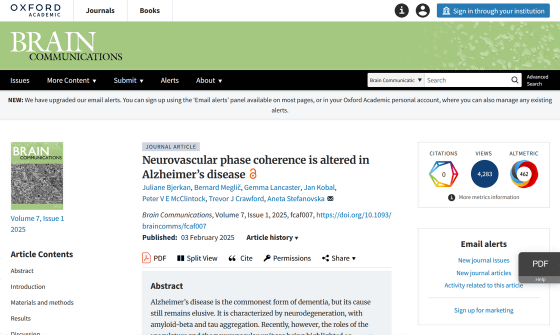Research results show that Alzheimer's patients breathe more frequently, which may lead to earlier detection of Alzheimer's

As the population ages and the birthrate declines, especially in developed countries, early detection of
Neurovascular phase coherence is altered in Alzheimer's disease | Brain Communications | Oxford Academic
https://academic.oup.com/braincomms/article/7/1/fcaf007/7994547

A new approach to detecting Alzheimer's disease - Lancaster University
https://www.lancaster.ac.uk/sci-tech/about-us/news/a-new-approach-to-detecting-alzheimers-disease
The Way You Breathe Could Reveal a Hidden Sign of Alzheimer's : ScienceAlert
https://www.sciencealert.com/the-way-you-breathe-could-reveal-a-hidden-sign-of-alzheimers
The brain needs oxygen to function properly, and a lack of oxygen in the brain can cause a variety of disorders. Now, a research team led by Lancaster University in the UK has hypothesized that the way the body delivers oxygen to the brain may play a role in neurodegenerative diseases such as Alzheimer's.
'We can hypothesize that Alzheimer's disease is the result of the brain not being properly nourished through the blood vessels,' says Aneta Stefanovska , professor of biophysics at Lancaster University. 'The vascular system and the brain work together to ensure that the brain receives enough energy. In fact, the brain requires 20% of the body's total energy consumption, even though it only accounts for about 2% of body weight,' says Bernardo Meglic , clinical coordinator of the study and affiliated with the Ljubljana University Medical Center in Slovakia.
The research team conducted an experiment to evaluate the function of the 'neurovascular unit,' which is made up of a vascular system connected to neurons via brain cells, in 19 Alzheimer's disease patients and 20 subjects without Alzheimer's disease.

'We measured the brain's electrical activity and oxygenation using a scalp-worn device, as well as heart rate using an electrocardiogram and breathing using a chest belt. Together, these data provide a picture of how well the physiological rhythms of breathing, heartbeat, brain oxygenation and electrical activity are coordinated.'
The results of the experiment revealed differences in nerve cells associated with the vascular system and in the fluctuations in blood oxygen levels associated with nerve cell firing between subjects with and without Alzheimer's disease. It was confirmed that the synchronization between blood flow and brain activity was significantly disrupted in the brains of patients with Alzheimer's disease.
In addition, Alzheimer's patients breathed more at rest than non-Alzheimer's subjects, breathing about 13 times per minute in normal subjects and about 17 times per minute in Alzheimer's patients. This may be due to the fact that the clearance of amyloid beta and the production of ATP are delayed in the brains of Alzheimer's patients, which changes the connection between blood vessels and nerve tissue.

The results of this study suggest that a breakdown in the function of the neurovascular unit, which reduces the flow of oxygen and the ability to remove harmful substances, may cause Alzheimer's disease. In addition, the approach using electrical and optical sensors used in this experiment is cheap and rapid, and it is expected that it may be useful for early detection of Alzheimer's disease.
'We also detected, completely unexpectedly, that resting breathing frequency was significantly higher in subjects with Alzheimer's disease. This is an interesting finding and, in my opinion, a breakthrough that opens up a whole new world of Alzheimer's research. This likely reflects inflammation in the brain that, once detected, is perhaps treatable and may one day prevent the severe stages of Alzheimer's disease,' said Stefanovska.
Related Posts:
in Science, Posted by log1h_ik







